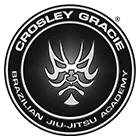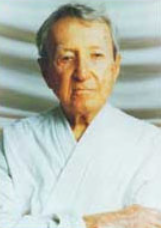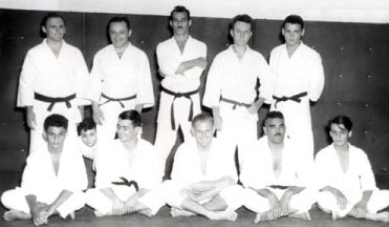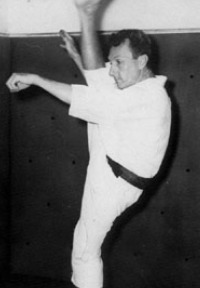About Carlos Gracie
Born on September 14th, 1902, Carlos was the first family member to make contact with the martial art that, in all of the blooming century, would be bound to the name Gracie Jiu-Jitsu, thus, was Carlos's life (and vice versa) ever since his father, Gastao, trying to canalize the energy of the boy who seemed limitless, made him learn a new fight style with a Japanese friend of his, Mitsuyo Maeda, a.k.a. Count Koma. At 14, thus, Carlos began a saga that, to the whole world's surprise, would pervade academies and rings across the planet.
Or could anyone guess? “Out of all pupils Koma taught, and they weren't few, as he used to travel the world teaching, only one fully understood the grandeur of that knowledge, adopting Jiu-Jitsu as a profession. Carlos had, since the very beginning, a good idea of the thing he was learning.
No wonder he created a school that's been lasting 80 years. Indeed, when Carlos became acquainted with Count Koma's techniques, in 1916, the young Gracie was still a developing personality, much like Belem, which worked as an entrance to Brazil, with influence of European and Japanese cultures, and on the other hand was nearly wild, with Indians, woods and rivers where the fearless would play.
At age 22, Carlos Gracie started to make a living out of Jiu-Jitsu. It was the time of challenges published on newspapers (“Want a broken rib? Look for Carlos Gracie,” one of them read). Carlos didn't look like a fighter, but like a chess player. He'd go to training in police academies. As they thought nothing of him, he had to demonstrate the efficiency of the art he believed in, that Jiu-Jitsu could do miracles and that he himself was a good fighter.
Carlos was always against associating Jiu-Jitsu with violence. Of course, in the beginning Carlos would place the ads and challenge those huge stevedores because, in the 1930s, there was the need of establishing an identity. That was when such comments began: 'The Gracie's are invincible.' 'The Gracie's settle businesses with their bare hands”.
But each historical moment is different. When, in the seventies, Jiu-Jitsu became a sport, there was no more need to prove anything. It's like today, when fighting or not fighting MMA starts being a personal choice; there is no longer the need there was in the times of Carlos and Helio, when they had to prove Jiu-Jitsu's efficiency in the ring.
One of the greatest heritages Carlos left was the power of discipline and will . He was never seen go by a day without exercising and meditating.
Nothing, however, deserved the family's gratitude more than the nutrition method elaborated by Carlos Gracie, for years, based on studies and thousand of experiments. After making his children, nephews and grandchildren listen to their bodies and eat exclusively what is beneficial to the organism, it's no exaggeration today to say that the last half decade meant 50 years of success of the Gracie Diet, whose basic principle is to avoid the excessive acidity in the nutrition, which to its creator was the main cause of the organism's deterioration and consequent malfunction of organs.
Thus the diet endeavors to keep the meals' PH as neutral as possible, balancing substances by using the right combination. Notwithstanding, reducing Carlos' science to this would be disregarding much of his work – He anticipated many of the much-divulged discoveries of today, like carotene's beneficial role, a substance found in the papaya and the carrot, the concept of free radicals and orthomolecular medicine, not mentioning his pioneering role regarding the habit of consuming acai, watermelon juice, coconut water, vitamins. And, when nobody spoke of nutrition, he noticed how useful it was to cut off red meat before Helio's fights, since meat gives you explosion power, but not long term resistance.
The interest for life and nutrition, like everything else in the descendant of Scottish, was not random. Together with growing suspicion toward traditional medicine, the specialist of the blooming art noticed the need to, with the diet, look after the main work tool, the body. Carlos Gracie, indeed, made four or five famous fights, the last of which against Rufino, in 1931, and another one – pure vale tudo (or 'no rules,' if you will) – in Rio de Janeiro, against capoeira practitioner Samuel. At one point Samuel saw himself with no choice but to grab Carlo's testicles.
The most famous one, nevertheless, was another Japan vs.. Brazil classic, held in Sao Paulo, in 1924. Against Geo Omori, self-proclaimed Japanese Jiu-Jitsu representative, Carlos made his most memorable fight. Nearing the end of the third three-minute round, Gracie gave the foe's arm an inexorable lock and looked at the referee, who told him to go on. Carlos broke the opponent's arm, but the latter paid no heed and gave an unfocused Carlos a takedown, before the end of the fight, which ended with a draw and mutual respect by the contenders, in a time when fighters only lost bouts by tapping or passing out.
Legend has it, however, that the most unforgettable scene was played by rooters from Sao Paulo, who threw their hats into the ring as soon as the Brazilian broke the foe's limb. For one thing is to apply it when the other guy is unfocused, but Carlos would warn beforehand, “I'm going to beat you by arm-bar,” and the opponent would shrink their arm. Then he developed a technique of getting to the arm when the adversary knew they were going to be arm-barred. That was the beginning of the perfecting of Brazilian Jiu-Jitsu, characterized by leading the foe to erring, where the weaker can defeat the stronger.
In the later years of his life, when he paid more and more attention to meditation after living a life of action. He was the guru but not in a restricted sense: he symbolized the values, the philosophy, the thinking and the greatness of the Jiu-Jitsu project.
In fact there's a reason for the connection most people draw between religion and Carlos Gracie. Besides being always a highly valued subject for Master Carlos and being one of the most evident facets of his life in the 90's, spirituality and mysticism was responsible for some delicious anecdotes Carlos lived.
Once he was visiting a dear friend of the family, Luzita, who just had a handicapped baby. They were chatting and Luzita was holding her baby when she noticed that Carlos was carefully looking at the child. She asked what he was thinking about and the Master said: “You can be cool because your son is going to achieve everything he wants in life. This handicap is not going to get in his way at all, much to the contrary.”
Said and done: the baby was Jean Jacques Machado, future Jiu-Jitsu phenomenon and ADCC world champion. Many believed Carlos to be a psychic. The result of that were not only benefits and wise advice for the whole family. There were also warnings that were taken for granted in the name of love.
Crosley and his sister Kandria with sit with Grandmaster Carlos Gracie.In personal matters such as his eating habits and the evolution of Jiu-Jitsu, the great Master really seemed to know which way to follow and anticipated a lot of what was to come. Since then the Gracie family has brought up three generations of fighters and instructors who now help spread the family knowledge to the rest of the world.



